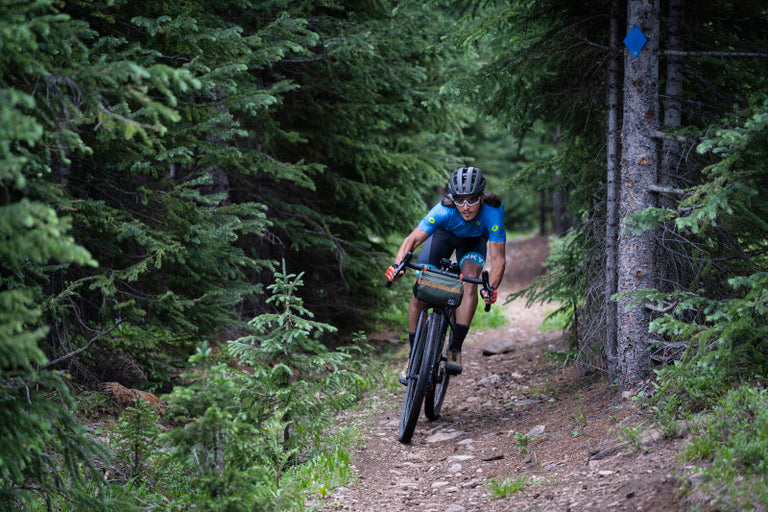When the gas light illuminates on the dashboard, thoughts turn to just how many more miles the car will continue to propel forward before it sputters out and comes to a halt. Without fuel, progression is impossible. Gnarly endurance cyclists know all about fueling’s relationship to moving forward. In turn, they understand that nutrition plays a huge role in success and just how quickly they can cross the finish line.
We checked in with cyclists on the Gnarly team to figure out what they know now about fueling that they wish they had known ages ago. Nutrition is always individualized, but learning from someone’s else's mistakes can often be less painful than making the same mistakes on our own.
Lael Wilcox
“The biggest change I've made since starting to work with Gnarly last year is focusing more on how nutrition can help my recovery—while training and racing. The Gnarly Vegan Protein, Performance Greens and BCAAs have made a world of difference in how I feel during multi-day events. I feel so much better and I can consistently ride so much faster.
Fuel₂O is my go-to for on-the-bike hydration and energy. I carried 10 packets for the Arizona Trail time trial and rationed them until I ran out (probably halfway through the 9 1/2 day effort).
I used to think nutrition didn't make a difference and I'm learning how wrong I was. I’m happy to be learning new things and improving!”
Blake Hansen
“I think the thing I’ve learned over and over and over and just keep learning is: eating enough between efforts/recovery is so crucial to sustained performance. However you’re doing it, whole foods or supplementation, there’s nothing worse for an athlete than under fueling. I’m constantly under fueling myself for fear of eating too much. Maybe due to stigma, I couldn't say, but we should all be putting those things away as athletes and properly fueling our bodies. Nothing is going to work the way you want it to unless you’re giving your body the tools it needs to work.”
Tommy Kline
“Over the years I’ve come to understand, both from experience and research, that fueling during workouts and races is everything. Especially during long endurance events, oftentimes the lead pack is whittled down not only by those who are strongest, but by those who are fueling properly, which means eating constantly during the race. When I started racing and training hard, I remember going out and going as hard as I could for as long as I could and often wouldn’t eat anything, or maybe I would take a single bar to eat at the top of the climb. I didn’t regularly bonk, but looking back I realize how much faster I could have been in races. I know there were several threshold or VO₂ workouts that I failed that I would have been able to get through with proper nutrition. Fueling on and off the bike is everything!
Nowadays I fuel very intentionally depending on the intensity and duration of my workout. This varies but in general my routine is:
- Two to three hours before the ride/race, I have a large meal full of a healthy mixture of carbs, fats and proteins. This is often oatmeal with berries, granola, muesli or a peanut butter and jelly sandwich.
- Right before the ride/race, I’ll have more carbs to kick off the digestion process, usually a bar, gel or peanut butter and jelly sandwich. I’ll also take some caffeine depending on the intensity.
- During the ride/race, if it’s hard intensity, I’m shooting for 60 to 90 grams of carbs as well as 300 to 400 calories per hour. Fuel₂O helps me hit these numbers.
- Post workout, I’ll usually make a smoothie with bananas, blueberries, peanut butter and Gnarly Protein. I’ll possibly follow that up with a huge salad to aid in my recovery, capturing not only those macros the body needs but all those micronutrients you get from veggies, seeds and berries.”
Leonardo Brasil
“For me, the Fuel₂O is a game-changer. On my 200-miles rides, I used to bonk fairly quickly. I really suck at eating on the bike so drinking calories, for me, was a game-changer. Last year on the Unbound XL 350-mile race, I carried 12 packs of liquid calories with me because I just suck at eating and I knew that if I relied on food I would bonk very fast. So I carried the 12 packages and I used every single one of them and I never bonked so that was perfect. Before I was using Fuel₂O, I was fueling with bars, gels, and water, but the gels never treated me well and I had a lot of gastrointestinal issues, and now I don’t even buy them anymore.
Another change is that a few months ago I started using the Gnarly Pre-Workout. A few weeks ago I did a 340-mile race in Iowa that I also did last year, but without supplementation. This year I used Pre and the start felt really good this year compared to last year. I decided to use those on my training rides as well as my racing and I think it really worked. I’ve had no gastrointestinal problems and I manage to keep at least five hours of consistent energy, so I feel like it helps a lot.
Also, Creatine has been a game changer for me. That product has made the largest difference in my training this year. I feel a lot more powerful now and my recovery time is so much faster.”
Alvin Garcia
“The first thing I’ve learned is just how important it is to fuel during training activities or racing. Especially once you start competing in endurance sports, you start to figure out how important it is to eat every hour or so depending on the activity.
Personally, I come from traditional sports like soccer, and there are many other sports that don't necessarily teach you a lot about nutrition, so I would just eat whatever and then show up to play and then recover afterwards and then try to be ready for the next game. But with cycling and endurance running, it becomes very, very important on how you prepare with nutrition.
I started with triathlons and I would only fuel at the beginning of the race and then maybe once during transitions. It's crazy now when I look back and I was just like, ‘Man, how did I do that?’ I would eat when I started getting hungry, but every endurance athlete knows that once you're hungry it’s past the point of proper fueling. Now I’m a lot more organized and prepared and I have a lot more structure to delay fatigue.
At times I was barely dragging myself to the finish line and at first, I thought it was just me being new and weak, but then I started learning, preparing well and eating well during the race and I started noticing that had about a 75 percent effect on how I was gonna do.
For recovery, I use my favorite Gnarly product—Performance Greens. I use that with Gnarly Vegan Protein to start my recovery and to be fresh, which is something I didn’t used to focus on. I’ve also started using Gnarly Pre-Workout mixed with Creatine in the morning or right before my workout, and it’s been amazing. I also use this more when I’m working as a route setter when I’m climbing all day and have these moments when I need a little kick. I definitely notice my wind come back really quickly with that.”



